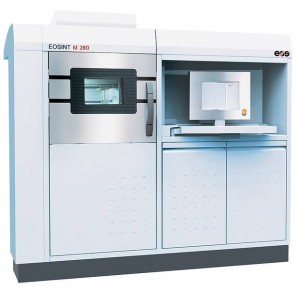EOS 3D printers are high-tech laser-sintering machines from a German company of the same name. These printers, of course, are big, bulky things, not suited for hobbyists or smaller offices; but as far as serious 3D printers go, EOS machines are fairly user-friendly and easy to use. EOS offers several lines of 3D printers which differ by the raw materials used for printing, and by options and quality: there are metal laser-sintering systems, plastic laser-sintering systems, and the somewhat rare sand laser-sintering machines. In fact, EOS offers the only 3D printer able to work with Croning moulding material – allowing for creation of moulds and cores for sand casting.
How do EOS 3D Printers Work?
All EOS machines use the process known as Selective Laser Sintering, or SLS (this video explains the process in-depth). It’s an advanced process which involves sintering the raw material, usually in powder form, via a laser beam. EOS 3D printers, however, differ from other SLS machines in that they’re highly automated and are designed for optimal utilization of machine capacity, as well as user-friendliness.
EOS metal laser-sintering 3D printers – specifically, the improved EOSINT M 280 model – come equipped with a 200 or 400 watt solid-state laser, which can boast a very stable performance and the Laser Power Monitoring system provides the user with control over the sintering process. The sintering process itself takes place in a sealed chamber and can operate in both nitrogen and argon atmospheres – expanding the range of materials and increasing the quality of parts produced. The choice of materials is wide and ranges from light metals to tooling-quality steel and superalloys. A variety of additional equipment options are available, ensuring great flexibility.
EOS plastic laser-sintering 3D printers are available in two lines of machines: FORMIGA and EOSINT P.
FORMIGA printers work with polyamide or polystyrene and boast high levels of surface quality, automation and user-friendliness, while at the same time requiring a minimum of accessories and having relatively low energy consumption levels. FORMIGA printers are optimized for production of small series or individualized products with complex structures – for instance, medical and consumer products.
The latest representative of EOSINT P printers – the EOSINT P 800 – is different from other plastic laser sintering machines in that it is able to print with high-performance polymers. Improving on the already good design of the EOSINT P 730, the new machine is able to process temperatures up to 385°C. This means that it gives you the ability to print plastic parts with very good material properties while being a great 3D printer all by itself.
The EOS sand laser-sintering 3D printer line is represented by the EOSINT S 750. This great device has a range of great capabilities – it’s fast, it boasts a large build volume, but its main feature is the choice of material – it allows for printing of Croning moulding materials. The EOSINT S 750 allows you to produce very high-quality castings while removing batch size limitations.
| Dimension 3D Printer Specifications and Information | |
|---|---|
| Technology | SLS (Selective Laser Sintering) |
| Build materials | Plastic, metal and sand materials – more information at the EOS website |
| Manufacturer’s website and contacts | http://www.eos.info, address: Electro Optical Systems, Robert-Stirling-Ring 1, D-82152 Krailling, Munich, phone: +49 89 893 36-0, SALES phone: +49 89 893 36-0 |
| Manufacturer’s forums and resources | EOS news and events |

